Open Your Eyes
The Legend of Zelda series producer Eiji Aonuma introduced in 2013 a new project that would “rethink the conventions of Zelda.” Skyward Sword was a step in that direction, blurring the lines between dungeon and overworld. A Link Between Worlds further paved the way, allowing players to explore dungeons in any order by offering every item upfront. But that wasn’t enough. Aonuma desired to see a world that was open to you from the start – one with no single correct track. With The Legend of Zelda: Breath of the Wild, the team at Nintendo has achieved creating a fully open world that is truly breathtaking.
Check out my video review here!
The theme of Breath of the Wild (BotW) is discovery. As such, I will avoid delving into any specifics, keeping this spoiler-free. Rather, I will offer the gist of what brings this game and all of its moving parts to life.
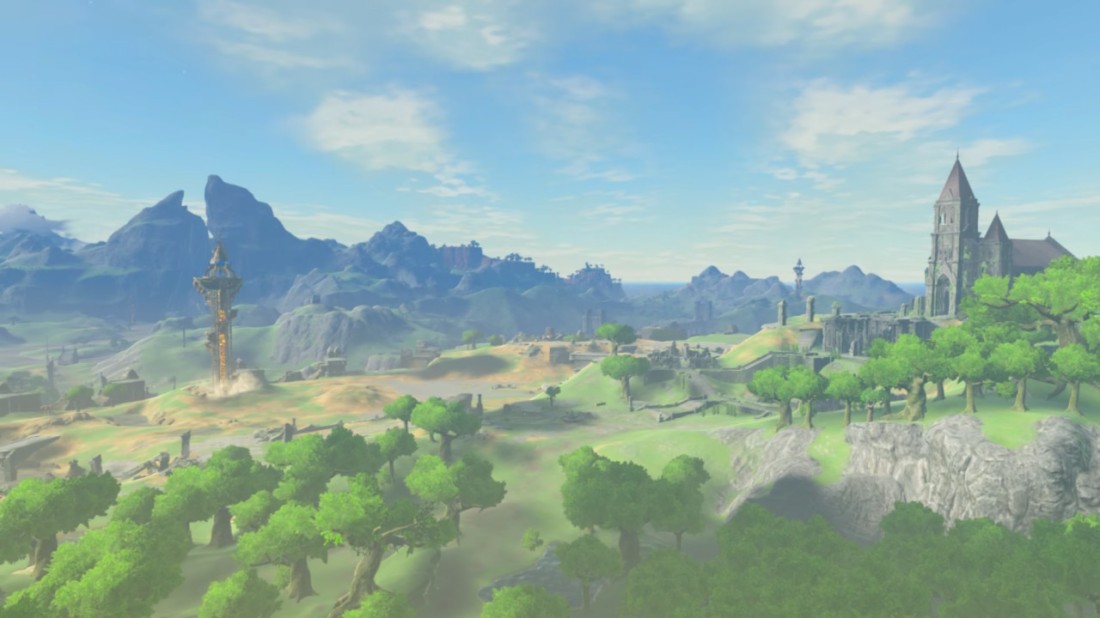
For the first time since the original The Legend of Zelda, BotW presents a world that is open to you all at once. You start your adventure on the Great Plateau, a rather large area that introduces you to the basics of open-world exploration and the tools at your disposal. Though this represents the tutorial, the game barely holds your hand, simply telling you what to do but not how. Once you are able to leave the plateau, BotW sets you free, not forcing you on any set path on your way to the final boss. It guides you and highly recommends quests for you to complete to buff yourself in preparation for the final confrontation. Otherwise, you have agency to do as you will and explore the world around you.

This sense of freedom may be a little jarring to anyone used to the scripted paths of most Zelda titles. The predetermined story markers are still there, except this time, you have the power to choose how to go about it. Do you follow the beaten path or climb the mountains surrounding it? From the start, you’re equipped to go anywhere. The only limit is whether you can survive that trek. At worst, you may lack the stamina – represented by a meter that depletes as Link runs, climbs, swims, and glides. But if you can persevere, you’ll find yourself reaching new heights overlooking a gorgeous backdrop. I took every opportunity to scale mountains, eager to see what surrounded me from a bird’s eye view. Jumping off high points and gliding down was a thrilling sensation every time.

The world is populated enough to provide personalized adventures. Although you may not find something new every minute, the environment is filled with enough variety to foster discovery. From an ever-changing topography to radically different climates to the series’ trademark bombable walls, surprises wait around most corners. There were many times where I thought I was heading towards one direction, then got sidetracked because something else caught my eye. By marking different areas on the map using stamps and glowing beacons, I could pin noteworthy areas. BotW never strayed from kindling my curiosity and wonderment.
If BotW is half-discovery, then the other half is survivability. Though skillful players may withstand every trial with the initial three health hearts and stamina bar, even the best of us will get a Game Over. In a game where you can accidentally run into enemies who take you out in one blow and where even the most dangerous mountains can theoretically be scaled, a “Game Over” just means you tried and didn’t succeed. In BotW, taking chances is encouraged. Following death, you simply reload at your most recent autosave or manual save, letting you have another go or retreat to better prepare yourself. Persistence after failure is a theme present through and through.

Breaking away from the precedent set before it by the first entry in the series, enemies no longer drop hearts. To regain much needed health, you are tasked with foraging and hunting for ingredients to cook restorative dishes. Although it’s tough figuring out what to cook given a blank slate, you quickly learn which recipes offer bonuses, such as an extra batch of temporary hearts or protection from severe weather. Keeping true to the notion of survivability, you must adapt to harsh conditions like the freezing cold, blazing heat that causes you to combust, and lightning that strikes your metal equipment. In addition to food, special armor sets give you the defense you need from certain settings while giving you the chance to dress Link up, which is always a treat. Affording armor and other items entails earning the standard currency of Rupees. As you’d expect, these don’t come easily either, and you’ll have to sell your resources for money. Though these new aspects paint a wholly different picture from previous entries, it drives home the concepts of hard work and survival.

With a world this vast, you’d think that it would be impossible to truly cover it. Luckily, a fast travel option allows you to warp to over a hundred shrines, crucial landmarks that I will explain soon. Aside from hosting special challenges, they also mark progress points that you can continue from if your current direction proves futile. You can also fast travel to tall towers scattered across the land, offering a regional map and a consistent vantage point from which to glide.
Of course, a massive open world means nothing if you can’t interact with it. Sneak towards a horse and mount it to reach blazing speeds. Strike rocks to set a fire and possibly an updraft that can soar you upwards. Ride your shield down hills and attack anything in your way. The sky’s the limit. BotW fosters an attitude of experimentation, telling you that it’s great to pursue whatever fun ideas you have.
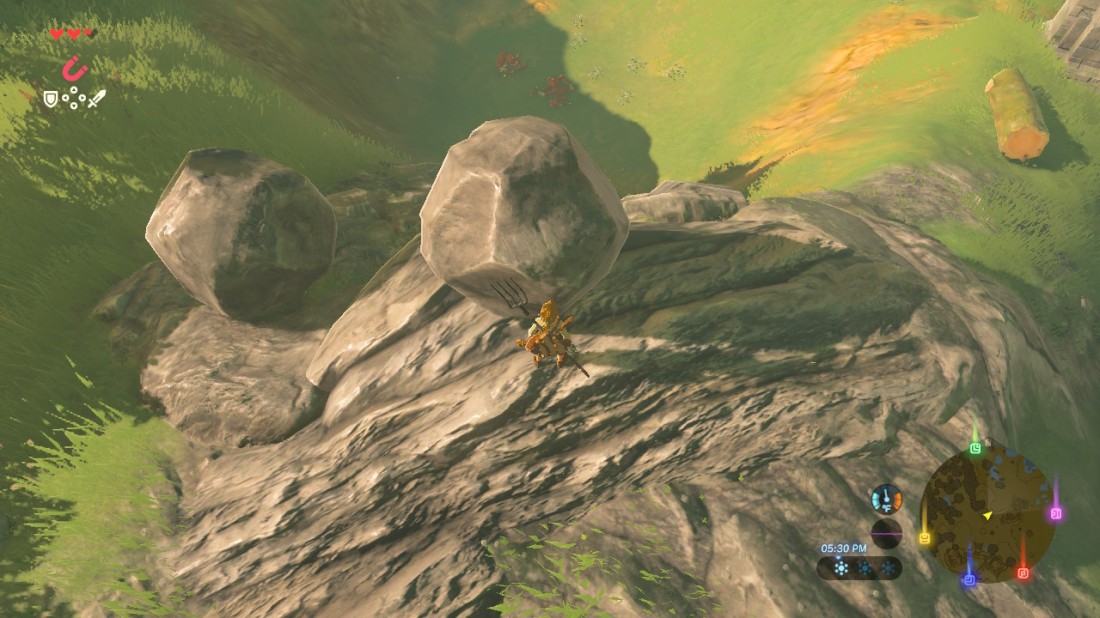
BotW equips you from the start with everything you need to play in this gigantic sandbox. We’ve come a long way from taking a single sword when it was dangerous to go alone. Now you can wield a variety of weapons – swords, lances, axes, mops – to face both new and classic Zelda foes. In addition to special properties, each weapon has a unique weight to it: two-handed swords are heavy but more destructive; lighter scimitars are fast but less powerful. Combat may feel a bit different to series veterans, but it utilizes the standard L-targeting that has prevailed since Ocarina of Time. Jump attacks, side hops, and backflips are still possible, but making perfect guards with your shield and unleashing flurry attacks demand carefully timed offense and defense. Likewise, using your bow entails precision aiming, guided effectively by the Switch’s gyro controls.
I’m not as fond of the durability system, in which your weapons and shields break after repeated use, mostly because I wanted to hoard my best weapons. Again, keeping consistent with the open world, this system is in place to foster exploration. Most enemies are holding a weapon, and besting them in combat leaves you with the spoils. Stronger enemies hold better weapons. Though it was hard to accept, using up my weapons on these tough foes led to satisfying rewards.
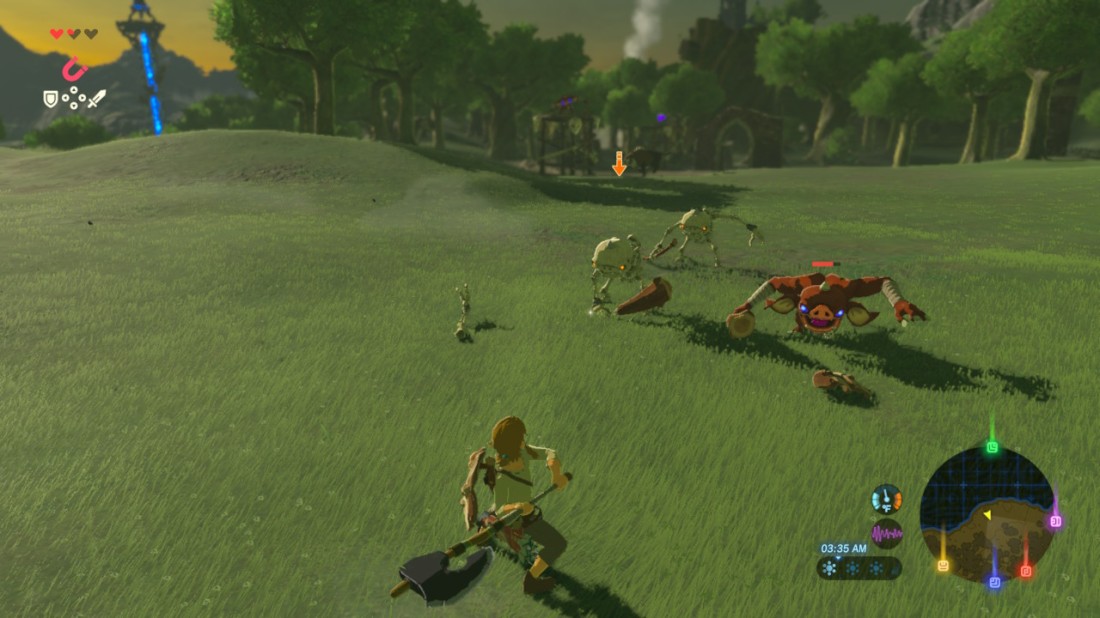
Fighting enemies isn’t your only option. You can stealthily sneak past them, run away as they chase you, or find a different way to tackle them. For instance, you may see an enemy camp below you and choose to either run in swords-blazing, shoot down each enemy, fire at a nearby explosive barrel, or chuck boulders at them. There is always more than one way to approach a situation, highlighted further by Runes.
Runes, special abilities that you access from your handy technological Sheikah Slate tablet, emphasize resourcefulness. The game awards you these powers early on, but continues to test you on their applications throughout your adventure. The Runes are simple to learn: Magnesis grants you the power to manipulate metal objects, Cryonis creates ice pillars from water, and Remote Bombs give you a limitless supply of explosives. The most creative Rune, Stasis, freezes an object in time, allowing you to whack it repeatedly, resulting in a release of kinetic energy that sends it flying. The physics are more sophisticated than in previous Zelda titles, permitting you to test out possibilities that you would have never considered before.

Your abilities are put to the test in Shrines, puzzle-filled mini-dungeons. These are the same kinds of rooms you’d encounter in full Zelda dungeons, except broken up into bite-sized chunks, consisting of one or two puzzles that rely on your Runes to reach the end. Despite the separation of puzzles, the 100+ Shrines deliver consistently high quality brain teasers. In some cases, the path to the Shrine is the test, presenting a variety of distinct challenges and sidequests.
This brings us to one of the biggest elements of the series: dungeons. The dungeons are smaller but more open-ended, unlike the typical mazelike structure. Though that design may not sound as appealing, I found myself loving the dungeons even more in BotW. Instead of giving you a linear path to the boss, you can explore freely, utilizing your assets to reach cleverly placed switches. Like in Shrines, dungeon puzzles test you not on a single ability, but on all of them, leading to gratifying “Eureka!” moments. Dungeons take this concept a step further by hosting tricky puzzles based on spatial recognition and manipulation of your surroundings. Culminating in boss fights unlike any other, the masterfully crafted dungeons stand out.
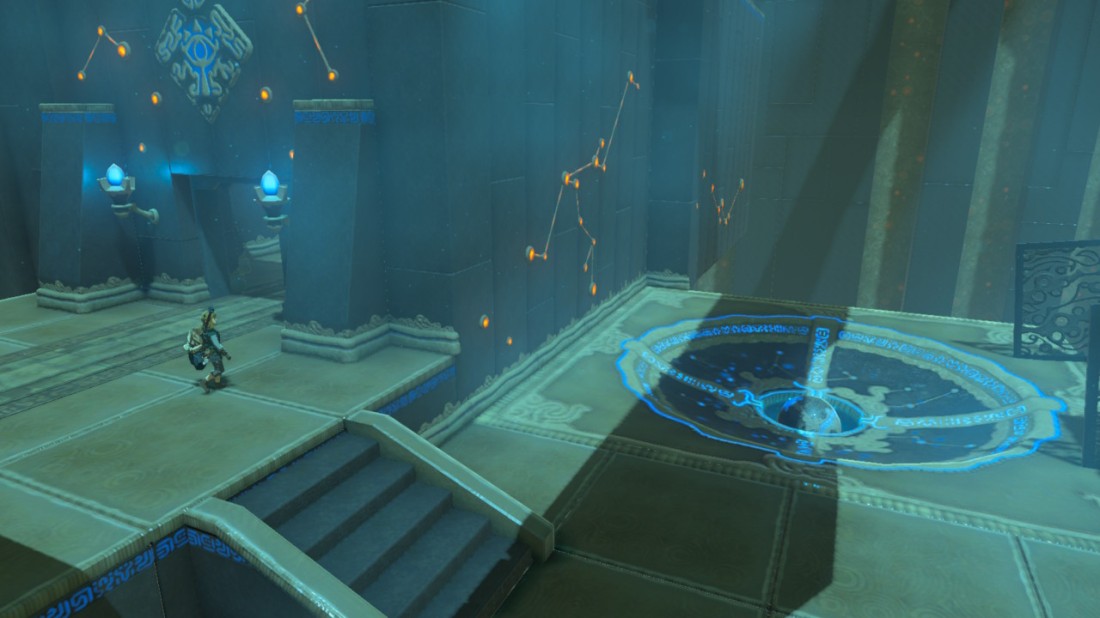
Dungeons also tie into the intricate tale. Though I won’t give out specifics, the story is well-told, in a fashion that fits the game’s motifs of discovery and open-endedness. In BotW, you search for the story, finding fragments of Link’s lost memories. No matter when you find them, the pieces of the past complete a jigsaw puzzle of revelations. Each memory progresses your own knowledge of the lore, giving you a reason to fight and help the people around you. Its worldbuilding seamlessly weaves into the open-world gameplay. The major characters are relatable, and the added effort to finally include proper voice acting expresses their emotions in a powerful way.
The art direction is marvelous, with gently painted cel-shading that evokes a style similar to the works of the legendary Studio Ghibli. In what Nintendo refers to as an open-air artstyle, every landscape could represent a complete, gorgeous painting. In motion, everything carries so much grace, from the grass blowing in the wind to the wild animals. The HD resolution is beautiful whether on the television or the handheld Switch screen. The framerate stutters a bit, especially in areas with updrafts and fire, but I didn’t have too much of an issue.
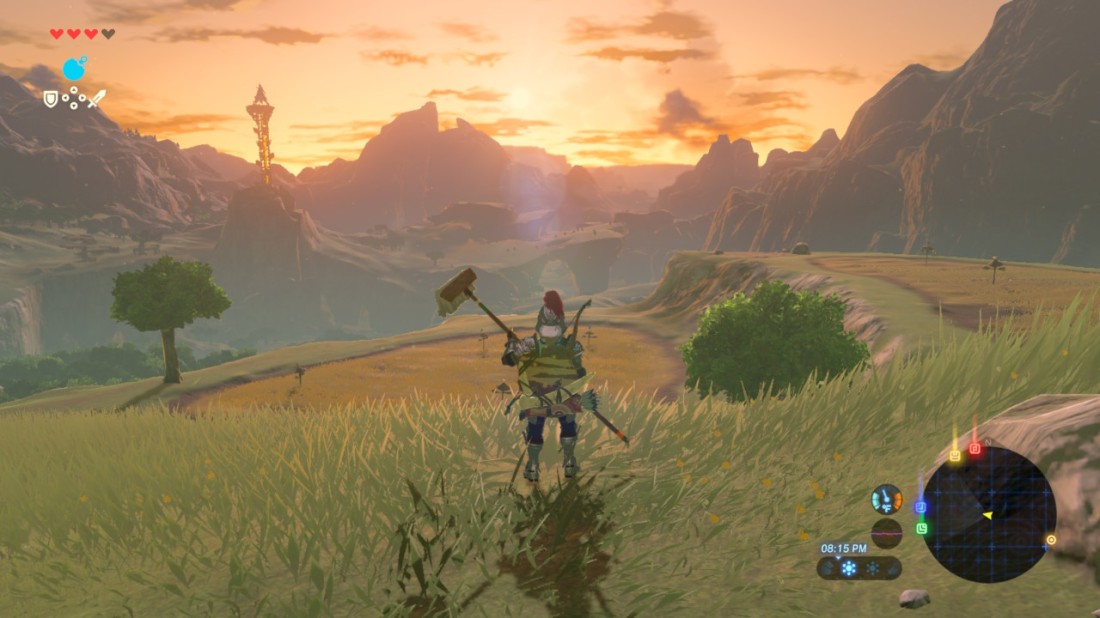
Light piano music plays softly and intermittently as you explore the open world. Though calling it a lack of music would be an exaggeration, there are a lot of quiet moments. This is perhaps my least favorite aspect of an otherwise stellar experience. The music in bigger, populated areas is beautiful while referencing prior series overtones, and the main theme is a highlight. Although I appreciate the effort to prevent repetitive music and create an atmospheric vibe, I found myself wishing for a more complete auditory experience.
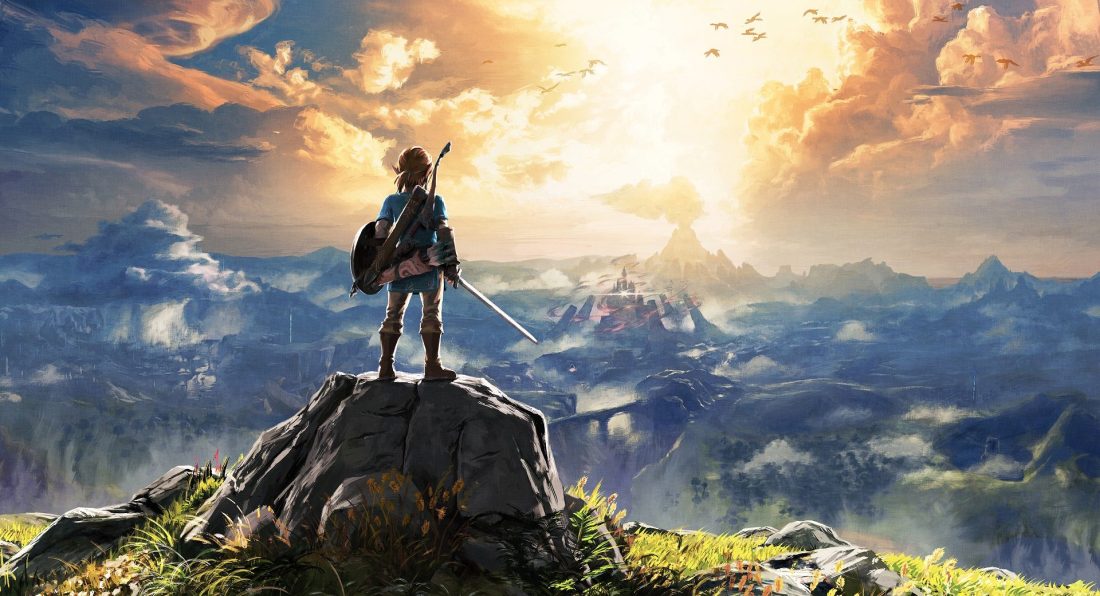
Conclusion
Telling an ambitious story that matches the breadth of its gameplay, Breath of the Wild interweaves a cohesive experience into Aonuma’s vision for an open-world Zelda. A curiosity to explore leads to discovery and necessitates survival. Hundreds of secrets populate the enormous world, and hours of playtime may only get you through one dungeon. But when the game’s physics provide so many opportunities for fun experimentation, it’s hard to regret any lost time. BotW throws tall mountains and vicious enemies at you, inviting you to rise to the challenge in ways you never thought possible. Once you’re on top, new opportunities continue to dangle in front of you, driving you forward on your epic journey. The Legend of Zelda: Breath of the Wild finally modernizes the original title’s adventurous gameplay, taking lessons from 30 years of Zelda and creating a new masterpiece that redefines the legendary series.
Score: 10/10
What are your thoughts on The Legend of Zelda: Breath of the Wild? Have any unique stories to share about your adventure? How would you like to see the Zelda series continue in future games? Please share any questions, thoughts, or experiences in the comments section below! Thanks for reading!
For more Zelda: Breath of the Wild, check out:
Zelda: Breath of the Wild DLC Set 1 Review – The Master Trials
Zelda: Breath of the Wild DLC Set 2 Review – The Champions’ Ballad
133 thoughts on “The Legend of Zelda: Breath of the Wild (Switch) Review”